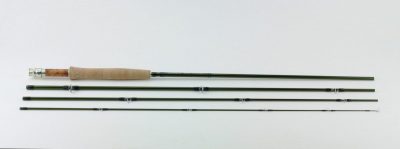Choosing a fly rod
 From graphite through to split cane, everyone has a different preference for the "ideal' rod. In fact many anglers will have several rods to suit the various types of fishing they enjoy. What is important is that the rod suits your style and requirements and that the reel and most importantly the line matches the rod.
From graphite through to split cane, everyone has a different preference for the "ideal' rod. In fact many anglers will have several rods to suit the various types of fishing they enjoy. What is important is that the rod suits your style and requirements and that the reel and most importantly the line matches the rod.
| Different materials | |
|
Most rods these days are made from carbon fibre. This is an ideal material for rods as it can be made to very accurate specifications. Carbon fibre is also very light - an important consideration when spending a day on the water. There are still some manufacturers who produce fibreglass rods which as less fragile but heavier to use. And there are some who manufacture rods from split cane - the original rod building material. |
|
| Different rod actions. | |
| Rods are built with different actions - each with their advantages and disadvantages. The action refers to the way the rod curves when casting. | |
|
Fast action A rod with a fast action is a powerful rod that has most of the flex in the tip sections. They require more skill to use but also are
|
|
|
Medium-fast action A rod with a medium fast action flexes further down the rod allowing the angler more control over the cast. It is also
|
|
|
Medium action The medium action rods have a compromise between precision and power and so are a good all round trout rod. The rod generally will flex for about half its length when casting. These are great rods to learn casting with.
|
|
| Slow action
Slow action rods are generally regarded as traditional rods in that they more closely imitate the action of the classic cane rods. They will often flex throughout the rod length and also are
|
|
| A good video showing the different actions of fly rods. | |
| Rod line weights | |
|
Line / rod weight The most important consideration is to ensure the rod and line match. Each fly line has a "weight" that ranges from 1 to around 12 or above. Most however fall between 3 and 8. Whatever rod you choose it is vital you choose the line to match it. Light weight rods (3 - 4 weight lines) The lighter the line / rod combination the softer and more delicate the presentation. But it will also mean that casting is more difficult in windy conditions and distance casting is not so easily achieved. Mid weights (5-6 weight lines) The most common weights as they provide a combination of delicacy plus able to handle a range of conditions as well as being to be cast reasonable distances. Heavier weights (7 -9 weight lines) The rods capable of casting heavy lines are used when distance rather than accuracy is important or the conditions are such that some weight is needed to cut through the wind. |
NZFishing.com
NZFishing.com is the complete guide to New Zealand trout and salmon fishing.


